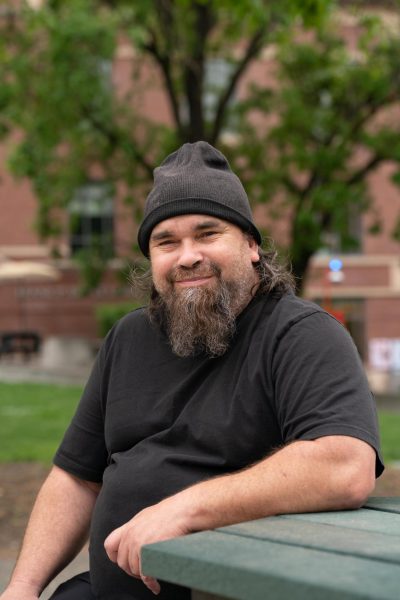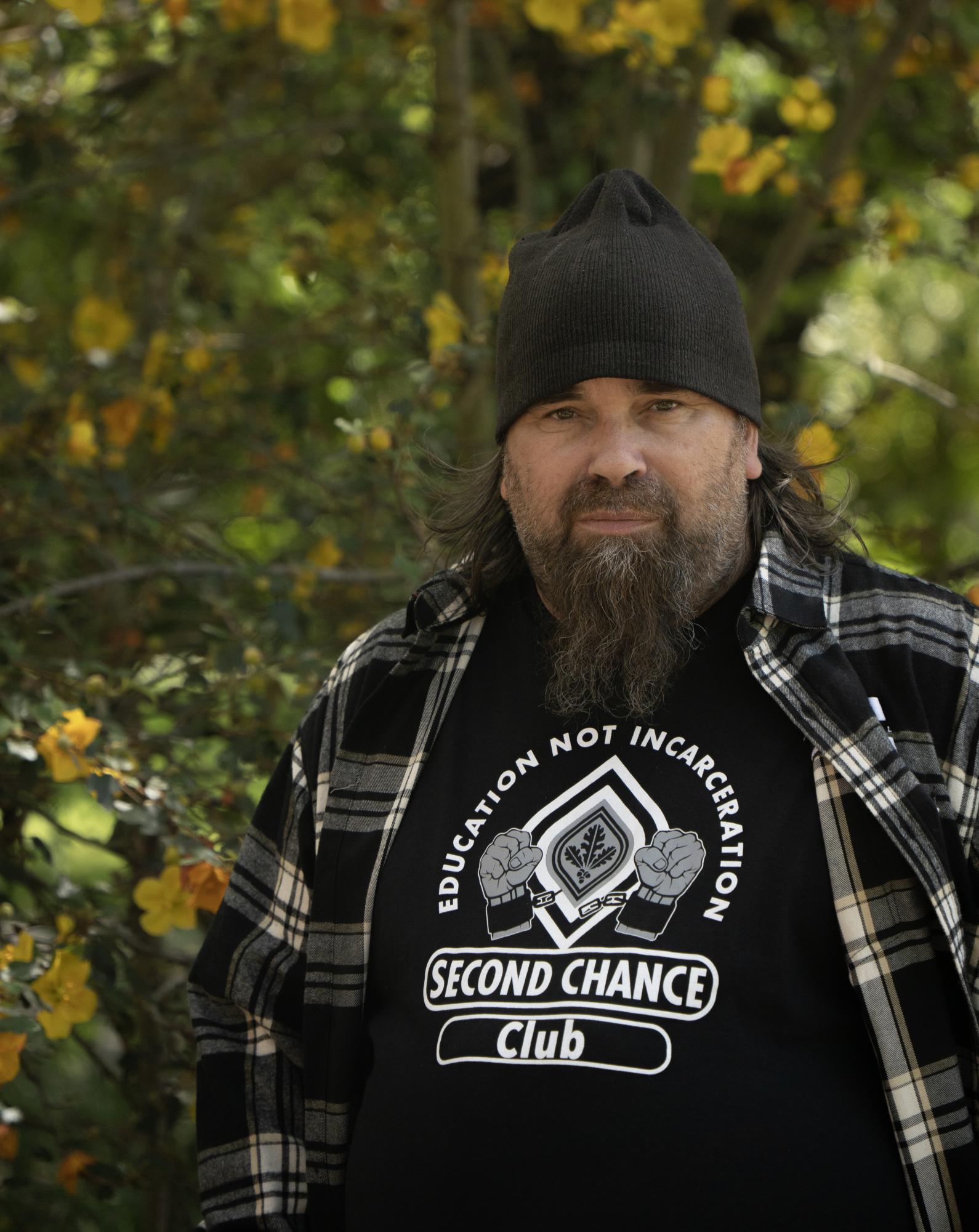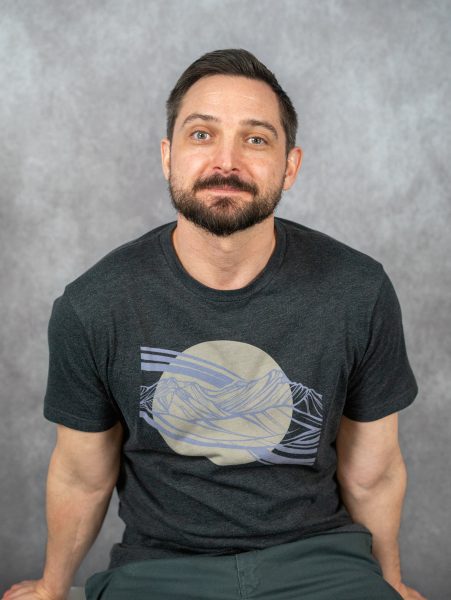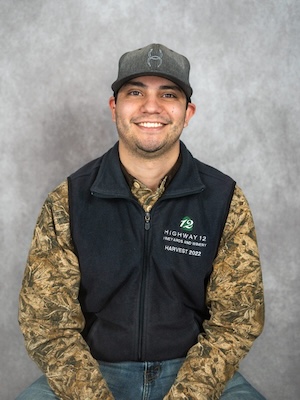Seven years ago, Santa Rosa Junior College student Kenny Hotchkiss had only one wish: to die.
He was 11 years into living unhoused with constant stints in and out of jail and nearly a lifetime of battling drug addiction, and he was ready to give up.
On Christmas evening 2017, his wish came true.
“A 6-foot, 300-pound kid [who] I knew ever since he was young proceeded to kick my stomach in with steel-toe boots,” Hotchkiss said. Too damaged to move from the spot of the attack, he lay moaning in his homeless encampment for two days until paramedics arrived.
“A person from my camp called 911 and gave an anonymous tip that someone was screaming ‘I’m dying,’” he said. “They came and got me and pronounced me dead on the way to the hospital from internal bleeding, a ruptured spleen and other damaged organs,” he said.
Despite a basic motor function test showing his body was responsive, two ER surgeons at Memorial Hospital passed on helping Hotchkiss due to a do-not-resuscitate order in his medical records.
However, the third and final surgeon on duty that night held true to his Hippocratic Oath and performed surgery, saving his life.
“If it wasn’t for that doctor, I wouldn’t be here. And when I came off of life support, he told me ‘I took a chance with you. Now do me a favor and do the next right thing.’ So since then, I’ve been clean and sober,” Hotchkiss said.
Six years later, Hotchkiss, 54, works full-time as a counselor at the Campobello Chemical Dependency Center in Santa Rosa and is gaining his Alcohol and Other Drug Counseling (AOD) Certificate at SRJC. He has his own apartment and car.
Hotchkiss’ warm smile would fit perfectly in a commercial if it wasn’t so genuine, and a few minutes of conversation with him could easily turn into an hour if one wasn’t watching the clock. Only his calloused hands, and perhaps too-blunt-at-times demeanor hint at the rough life he’s led, yet Hotchkiss still struggles with the perception the general public has toward people with similar backgrounds.
“When you think of people who have been to jail, you think tattoos, guns, drug addicts, people who have done just all this bad shit,” he said. “There’s always going to be a stigma about if we should be allowed to be reformed and mingle with society. That we don’t want to change our lives.”
Hotchkiss is one of at least 10,000 formerly incarcerated Californians who attend a community college, according to Kelly Nadler, the Bay Area coordinator for the Rising Scholars Program, which provides state support and services for students previously or currently incarcerated. He is also one of the 172 formerly incarcerated students within the SRJC Rising Scholars Program, along with the Second Chance Club, a student-run club for formerly incarcerated students.
Despite wanting to achieve a better life for themselves, the feeling that they don’t belong in a college setting is often a significant barrier to success.
Even though more than 60% of previously incarcerated students desire to get a degree, fewer than 4% actually do, compared to 29% of the general public who get degrees, according to a 2018 study by the Prison Policy Initiative.
Hotchkiss enrolled at SRJC with his family’s encouragement. Eventually, he was able to gain momentum academically from the support of the Second Chance Club.
Second Chance became a student club in 2015 and eventually an official Student Services program that works under the Rising Scholars umbrella in 2018. At that time, it served about 20-25 students but has grown to about seven times that number. Rising Scholars also serves 20 students who are currently incarcerated in juvenile hall this semester and youth in the community who are attending continuation schools.
A major scope of the Second Chance Club is providing a space where previously incarcerated students can find confidence in themselves by meeting others like them who are excelling at school, said Jessy Paisley, Second Chance faculty coordinator and Rising Scholar counselor. They also use campus outreach to try to reduce the stigma members face.
At meetings, counselors provide training for members to comfortably share their stories with other students at campus club days. “If somebody says something that is hurtful or makes you feel not good inside, how do you respond to that? How do you take care of yourself after interactions like that?” Paisley said.
So far they’ve been successful. In her two years as faculty coordinator, Paisley has noticed more students have become accepting of Second Chance as they learn more about the club.
Paisley said SRJC administration has also become more Second Chance-friendly by opening up student employment opportunities, such as teaching assistants and tutors in the campus tutorial center.
The Rising Scholars Program offers services such as grants for the SRJC Bookstore, peer coaches who can help students with school and online work and referrals for off-campus assistance. Another benefit of the program is that it works with The Access Project (TAP) that helps members expunge their criminal records.
Within Rising Scholars is the IGNITE program in which SRJC faculty teach classes at Juvenile Hall and the Sonoma County Main Adult Detention Facility, or MADF. Besides social and human services classes, SRJC instructors teach kinesiology, creative writing and humanities.
The Second Chance Program counselors receive rosters of inmates who took the classes while incarcerated, so they can call them after their release to entice them to enroll at SRJC. “We usually get two or three students a semester that were enrolled at MADF and come to campus to keep going,” Paisley said.
These programs greatly enhance the academic performance of formerly incarcerated students, with half of participating students receiving a 4.0 GPA and over 80% receiving higher than a 3.0 GPA, according to a 2020 Stanford Law School study. They also reduce recidivism rates by 48%, which increases with every degree students earn, according to the Vera Institute of Justice.
And of course, there are also the Second Chance Club’s weekly meetings.
Paisley said new members often start out quiet. After a month or two they begin to share, and by month four, they’re likely to become actively involved in club days.
“Kenny [Hotchkiss] is an example,” Paisley said. “I remember him starting a few years ago and he was quiet, for Kenny, and now we really rely on Kenny’s positive attitude, welcoming nature and vulnerability.”
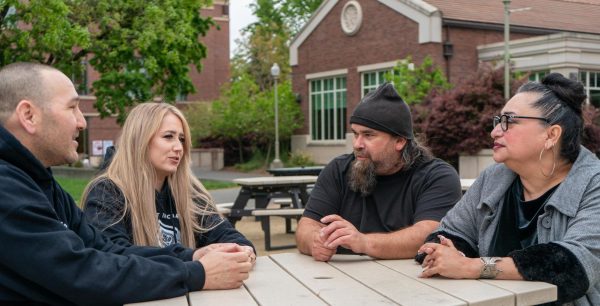
Hotchkiss immediately joined Second Chance in his first semester at SRJC, spring 2023. He said a lot of members call it a class, but it’s really a place where they can be themselves.
“To forget about the stigma, forget about society and how people look at us, how they frown at us or flinch when they see us,” he said.
Now he almost never misses a meeting. From his struggles with drug addiction, he knows how easy it is to slip into the deep end without constant support and check-ins.
His drug use began early, when he was only 9. Hotchkiss grew up in San Francisco as the youngest of five siblings, with an overall 15-year age difference between them. His dad was a Vietnam War medic who continued to serve there after it ended, for clean up purposes. Since he was gone a lot, his mom placed the responsibility of watching Hotchkiss to his brothers and sisters. They often did drugs and would offer him some.
“I think it was an easy way to keep a tab on me. ‘Drink this, smoke this.’ If I liked it I wouldn’t go anywhere. I would stick right with them,” he said. “So I grew up a lot faster than I should have. When I was 9, I would pretend I was like 14.”
Soon, Hotchkiss began having run-ins with the law. “I’m what they call an OG gangster. I knew a lot of the original gangbangers through my brothers and sisters. I grew up with them,” he said. Most of the crimes he committed were graffiti. When he was 15, he got busted tagging a federal building. Besides spending time in juvenile hall, he received some serious community service of scrubbing helicopter pads in Alcatraz. “There’s some big ass helicopter pads out there,” he said.
At 16 he moved to Petaluma and attended Casa Grande High School. Since Hotchkiss had access to drugs through his dealers in San Francisco, he became the go-to hookup. Through his early 20s he considered drugs as a fun time, but his use turned to “maintenance” as life grew more complicated with work and starting a family.
“I had two kids. My wife didn’t work. She stayed home to take care of them. So I had like three jobs. I just kept going,” he said. Despite short stints in jail due to drug possession charges, Hotchkiss never slowed down.
He ran a personal carpet and upholstery cleaning business, so his criminal record didn’t get in the way of employment at this time.
However, it wasn’t until much later in life that Hotchkiss realized he also resorted to drugs as his only form of therapy, an attempt to gain the emotional grounding he never learned as a kid, even if it was only temporary.
He had endured a lot of physical, verbal and mental abuse from his brothers and sisters. “They beat the hell out of me,” Hotchkiss said. “My dad had been a raging alcoholic and drug addict, too. So my drug use was to disguise the trauma I went through. When I share my story today, I tell people drugs and alcohol wasn’t my addiction. It was my solution. To correct my anger.”
With no support and no one to tell him to quit, his true addiction set in and maintenance wasn’t about the lifestyle, but holding withdrawals at bay.
“I had to keep it going, or else I would get sick,” he said. “Your body hurts. Your mind hurts. You’re throwing up. You’re shitting yourself. All this stuff your body’s not used to doing, and all you want is to cure that.”
It eventually caught up with him, and he simply let his carpet and upholstery cleaning business go. He also lost his housing.
For the next two to three years he and his wife lived in motels, a van they owned for a time and even storage sheds. They grew apart and Hotchkiss began living on the streets. He couldn’t get a job because of his criminal record or his inability to pass a drug test, and being homeless didn’t help.
According to the study from the Prison Policy Initiative, the unemployment rate among previously incarcerated people living in the U.S. was over 27% in 2018, the most recent data available.
This is almost five times the rate of the general public and higher than the total unemployment rate during the Great Depression. The study indicates that employers don’t want to hire formerly incarcerated people and not their unwillingness to search for jobs. Employers are legally prohibited from asking about convictions in California, though they can still run background checks.
This means the previously incarcerated are more likely to get stuck in poverty. They are also, like Hotchkiss, 10 times more likely to become unhoused, according to the National Low Income Housing Coalition.
There are 595 SRJC students who have reported being homeless, according to Fall 2023 data, almost 30% more than the 352 students housed at the Polly O’Meara Doyle Hall Dormitory, which opened last semester.
For Hotchkiss, the cycle of jail and living unhoused lasted over a decade.
“Days became weeks, weeks became months, months became years, which all blurred together,” Hotchkiss said. “You can imagine how quick a day or a week can go when you’re not taking time to rest. When you’re always having to break down camp and move it again. Or you’re being taken to jail. You don’t even know how many days you’ve been in jail before being released. That was my routine for a long time.”
He said between the age of 22 to 47, he’s spent half his time in jail. “I was what they call a frequent flier. Once you’re in the system, it’s easier to go back. You just go in and out, in and out,” he said.
Most of Hotchkiss’ arrests were for drug possession, with some for vagrancy. He said it was easier to get arrested because the cops knew his face and were aware he had a substance use disorder. If they saw him, they’d search him, and odds were he was carrying an illegal substance. According to the Prison Policy Initiative, more than half of people who are arrested multiple times report having a substance use disorder and 20% of people incarcerated in the U.S. are there for drug-related offenses.
To Hotchkiss, the difference between life on the streets or life in jail was either having to live like an animal or being treated like one.
“When you’re homeless you have to worry about people stealing your shit, your bike, your clothes or drugs,” Hotchkiss said. “Nobody stole in jail because you didn’t have anything. You have to fight for your food when you’re homeless. In jail, you just had to stand in line. But at least you got a name in jail. On the street you go by ‘hey you’, or ‘hey homeless.’”
By the time of that fateful Christmas night, Hotchkiss had lost most of his self-worth.
He knew his attacker had anger issues and was out for blood. When the “kid” started kicking Hotchkiss, he welcomed the onslaught, saying, “You can’t kill something that’s already dead.”
The last thing he remembers of the waking world that night was the ambulance doors closing and a paramedic saying “we’re losing him.”
While unconscious and on life support, he remembers dreaming. Dreaming of his mother, brother and cousin, all of whom had been dead for years.
“They were so vivid. I could see them just standing there and they were telling me ‘Go away,’” Hotchkiss said. “I said, ‘I just want to be with you,’ and they were like, ‘No, you’re not welcome here. You’re not ready to be here. Go back home.’ I said, ‘I am home,’ and they said ‘No, you’re not.’”
Hotchkiss felt rejected when he woke up at Memorial Hospital surrounded by tubes and machines. “Now I realize it was them telling me I had a purpose,” he said. “I didn’t understand until I got more into recovery and into doing what I do now.”
The hospital discharged Hotchkiss on Jan. 9, 2018. He weighed about 120 pounds, about 70 pounds lighter than usual, with staples in his belly, yet still had to make it to a court date a week later. He faced up to 15 years in jail because of multiple charges for trespassing — setting up camp in private lots — and breaking probation, which added up in years.
Luckily, with the help of his medical papers, he was able to convince the judge to take “pity” on him, and he received Drug Court, which is an intensive drug program, instead of jail.
Drug Court worked. He’s been clean since Dec. 28, 2017, the day the ambulance picked him up. Besides his sober date, he also calls it his “rebirthing.”
Once clean, he was eventually able to get a job as a detox counselor at the Campobello Chemical Dependency. He then enrolled at SRJC in spring 2023 because he wanted to get his AOD certificate and make his counseling position official.
Interestingly enough, this was not his first experience on the SRJC campus, but his first in which he didn’t get arrested.
Hotchkiss said his classes were initially on Zoom, a pain since he’s not tech savvy. In-person was better, but then he started to feel self-conscious because of his age, a common issue among Second Chance members.
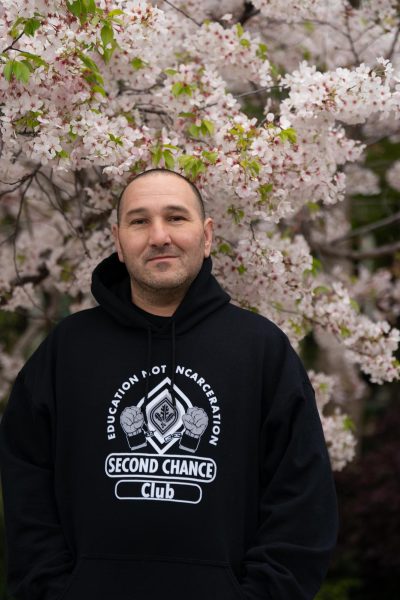
Jason Dorfer, president of the Second Chance Club, said it was intimidating to come onto campus in his late 30s when most of the students are 18 to 21 years old. He felt like he was under the microscope.
“When people find out you’re a felon, they look down on you like you wouldn’t want to be looked at, like a cockroach,” he said.
His time in jail had also damaged his self-esteem, making him self-conscious around others. “It’s really draining on your brain, on your well-being. When I got to Second Chance, it’s like I didn’t trust my own shadow, let alone other people,” Dorfer said.
His father, who was a drug addict, introduced Dorfer to drugs when he was 7. He said he didn’t have a chance to learn right from wrong as he grew up, and he’s been in trouble with the law for most of his adult life.
“I was running the streets hard, and I didn’t have any way to stop,” he said.
Dorfer, 46, was eventually sentenced to Drug Court, where he first met Hotchkiss, and since then he’s been sober, going on nine years.
He decided to enroll at SRJC after mentioning he was interested in welding to his probation officer.
Through his time with the Second Chance Club, he learned to open up and trust others. He also found common ground with members.
“They’ve been down rocky paths, and they are trying to do something different. So then, I wanted to do something different,” Dorfer said. “I started to feel like these people were my family. My mom is my immediate family, but the Second Chance club knows more about me than my mom does.”
Since then he’s been thriving. At SRJC he has obtained three welding certificates. And he got his criminal record expunged through Second Chance, which he sees as gaining back the name he lost as a child.
He’s also found employment at SRJC as president of Second Chance, and a peer mentor. As a peer mentor, Dorfer checks on inmates at juvenile hall, usually one to three times a week. They can talk to him, and he can also help them cope with adjusting to life outside.
“If someone is struggling with having a relapse, I’ll take them to a meeting,” Dorfer said. “I’ve sat next to somebody on Thanksgiving at an NA meeting in Cotati, from like 7 at night to early in the morning.”
He is legally kept from mentioning people he has mentored, but said quite a few of them have come to Second Chance meetings after their incarceration, then graduated from SRJC to enter well-known universities around the Bay Area.
“That can happen to you. You can go down that rabbit hole, then get out and succeed. People who have thought that they had nothing in life have pulled miracles,” he said.
Like Dorfer, Hotchkiss has begun to see his enrollment at SRJC as a chance to be an advocate for previously and currently incarcerated.
“I’ve been a failure for so long in my own mind and to society, and now I have this big freaking opportunity to prove to not just myself but other people, that I can do anything,” he said. “I’m 54 years old, father of three. I’ve got six grandkids and one [more] on the way, and I would never have thought that I’d be going to college, working on a certificate that can turn into a bachelor’s or master’s [degree].”
Hotchkiss has also realized that community college students are more used to seeing classmates of various ages. Despite his initial self-consciousness about being older, the confidence he’s gained from the Second Chance Club has led to him becoming more outspoken in class. He’s noticed that younger students expect him to know things they don’t, like about events that happened in the ‘80s and ‘90s, and ask him a lot of questions.
From his confidence, Hotchkiss also doesn’t mind “drilling the instructor” about something he doesn’t understand in class. He expects other students, who may be shy, to appreciate this from him.
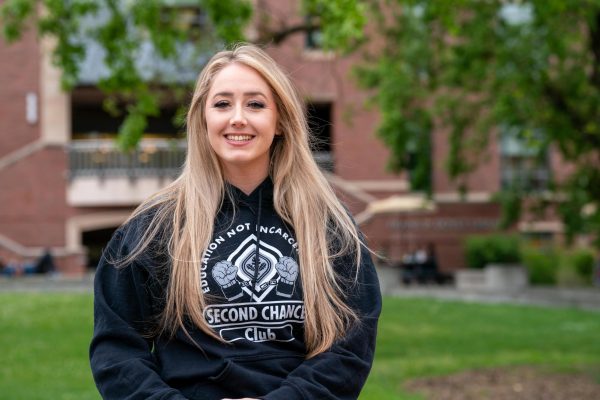
Hali Brenner, the Rising Scholars Program administrative assistant, didn’t have to deal with the stigma of being an older student when she enrolled at SRJC at 23, but she still felt like an outsider on campus due to a felony on her criminal record and struggles with addiction, which lasted for 10 years starting at age 11.
She also had extensive trauma from being a victim of human trafficking from age 18-21.
“I thought that ‘felon’ and ‘addict’ were stamped on my forehead,” she said. “I had so much baggage and horrible PTSD. It was so fucked up. It’s funny because even though no one can see it, you swear they’re just staring at you and judging you, when they have no idea.”
Before entering SRJC and Second Chance, Brenner had bleak predictions about her future, either expecting to spend her life in prison or end up in a ditch with a needle in her arm. Luckily, while in jail, she simply saw a “glimmer of light,” and dove into programs. At 29, she has been sober for eight years.
She said working at tables on club days helped her develop a sense of empowerment over her trauma and dismantle her imposter syndrome, a feeling of being a fraud or not emotionally accepting success despite personal achievements. Now, when she participates in outreach to local high schools, she appreciates the chance to empower other students. After club presentations, she said girls would approach her to share their own stories of sexual abuse.
Brenner also found her own personal empowerment through writing and taking English classes at SRJC. After reading works from other authors from incarcerated or gang backgrounds, she’s found there is healing when writing about trauma.
She is working on her own memoir, unofficially. “Because my story has purpose. My pain has purpose,” she said.
Since then she has earned her associate’s degree in English at SRJC and is now working on her master’s degree at Sonoma State University. With an interest in pedagogy and rhetoric, Brenner wants to eventually come full-circle and teach literature at SRJC. She thinks it’s critical for people like her to initiate discussions about reentry and fight stigma around incarceration since traditional students won’t understand it on their own.
Hotchkiss said his presence in class, and blunt openness about his past, often sparks discussions about incarceration and drug addiction. Students usually don’t believe him at first when he opens up about himself because he is doing so well. “You make it look easy,” they tell him.
But he is quick to remind them of the effort he has put into recovery. A big part of that is taking classes at SRJC and his pursuit of an AOD certificate, which he said gives him focus.
He is also a member of the Students For Recovery Club for students who struggle with addiction and is a sister club to Second Chance, with Paisley as coordinator as well.
Students For Recovery Meetings cover more than addiction, but also mental wellness and how that affects school. “If you don’t have your mental illness and self-care in check, your recovery doesn’t mean shit,” Hotchkiss said.
He thinks a lot of people hesitate to join these clubs because they don’t know how to talk about their mental illness.
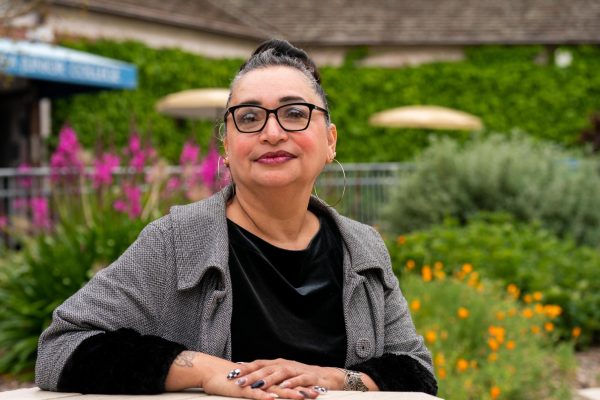
However, Second Chance and Students For Recovery member Martha Piña, 51, said everyone is so “damn friendly” that it’s too easy to bond with other members and eventually open up to them.
Piña enrolled at SRJC two years ago to get her AOD certificate since she thought that it would lead to the only gainful employment she could get with a criminal record. She struggled with alcoholism since her first time getting drunk at 14, and it eventually led to her third DUI and a felony. It cost her a 21-year career that she loved, but it did lead to sobriety, and she’s been in recovery for six years.
As an introvert and someone who doesn’t like to join groups, she only entered the Second Chance Club because it offered criminal record expungements. “But my mentality is: if I’m going to take, I’m also going to give, so I decided to join their weekly meetings. Then I started to share,” Piña said.
Second Chance gave her a sense of community, one that extends beyond campus. She said members create a network when they leave SRJC and find human service jobs and are able to help new members with essentials like food and housing.
After a year in Second Chance, Paisley asked Piña if she wanted to be a student success coach within the program. Piña already has an associate’s degree in child development and will get three more degrees this semester; in social work and human services: addiction studies, social work and human services: advocacy, and social and behavioral studies.
“I don’t struggle with academics, but I know a lot of people who have been incarcerated do, and they don’t have experience in academic settings,” she said.
As Piña started participating more at school and Second Chance, she said something shifted and she felt a desire to expand her education beyond SRJC. She plans to transfer to Sonoma State in fall 2024 to pursue a bachelor’s degree in sociology.
Piña said the Students For Recovery Club goes in and out of being active, depending on who can run it. She overcame her introversion again and, along with a few other members, restarted Students For Recovery two years ago.
The special thing about Students in Recovery, she said, is that it is inclusive to all paths of recovery.
“We’re all familiar with the 12-step program for AA (Alcoholics Anonymous),” Piña said. “Some people love it, and some, like myself, don’t vibe with it. Everyone’s different and has their own way. We embrace that.”
Students For Recovery has two meetings a week. Since a lot of Second Chance members also have substance use issues, this gives them the opportunity to attend support sessions three times a week. Members also have chances to meet outside of meetings and learn to socialize without the need for substances.
The club recently held an event showing a film about a man who killed someone during a DUI and got 30 years of jail for it. “I took my 13-year-old son to that because it was a kind of apology letter to him. But my main amends is him seeing me not drink and do better things,” Piña said.
Hotchkiss feels that treatment is all about facing the hard truth. When he’s working with a patient at Campobello and they start crying, he makes a point not to give them a tissue. “You got to feel that shit,” he said. Once the tears pour down your cheek, you’re releasing all that fear and animosity that’s been pent up for the last 20, 30, 40 years.”
He likens his life to that of a caterpillar. Caterpillars hide in their cocoons to one day gain a pattern and become a butterfly. He’s been locked up for so much of his life that now is the time to break free and show the world that he is beautiful. The evil of stigma, he said, is it makes people think that everyone who has been through what he has isn’t a butterfly.
“We’re ordinary everyday people. Some of us hide it because we have scars, mental and physical,” Hotchkiss said. “Society looks at us as always being bad. But we’re not bad people; we’ve just made bad choices or been in bad situations.”
Second Chance gives them the opportunity to change that, he said. “We’re kicking statistics’ ass. We’re making stigmatizers look like they’re the bad people. The ones that make up the stigma need to look at themselves and ask, ‘Am I making this worse?’”
